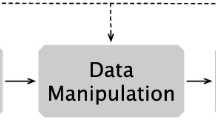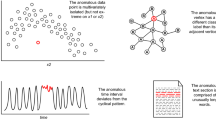Abstract
Skyline queries are often used on data sets in multi-dimensional space for many decision-making applications. Traditionally, an object p is said to dominate another object q if, for all dimensions, it is no worse than q and is better on at least one dimension. Therefore, the skyline of a data set consists of all objects not dominated by any other object. To better cater to application requirements such as controlling the size of the skyline or handling data sets that are not well-structured, various works have been proposed to extend the definition of skyline based on variants of the dominance relationship. In view of the proliferation of variants, in this paper, a generalized framework is proposed to guide the extension of skyline query from conventional definition to different variants. Our framework explicitly and carefully examines the various properties that should be preserved in a variant of the dominance relationship so that: (1) maintaining original advantages, while extending adaptivity to application semantics, and (2) keeping computational complexity almost unaffected. We prove that traditional dominance is the only relationship satisfying all desirable properties, and present some new dominance relationships by relaxing some of the properties. These relationships are general enough for us to design new top-k skyline queries that return robust results of a controllable size. We analyze the existing skyline algorithms based on their minimum requirements on dominance properties. We also extend our analysis to data sets with missing values, and present extensive experimental results on the combinations of new dominance relationships and skyline algorithms.
Similar content being viewed by others
References
Bartolini I., Ciaccia P., Patella M.: Efficient sort-based skyline evaluation. ACM Trans. Database Syst. 33(4), 1–49 (2008)
Bentley, J.L., Clarkson, K.L., Levine, D.B.: Fast linear expected-time algorithms for computing maxima and convex hulls. In: SODA, pp. 179–187 (1990)
Bentley J.L., Kung H.T., Schkolnick M., Thompson C.D.: On the average number of maxima in a set of vectors and applications. J. ACM 25(4), 536–543 (1978)
Börzsönyi, S., Kossmann, D., Stocker, K.: The skyline operator. In: ICDE, pp. 421–430 (2001)
Chan, C.Y., Eng, P.-K., Tan, K.-L.: Stratified computation of skylines with partially-ordered domains. In: SIGMOD, pp. 203–214 (2005)
Chan, C.-Y., Jagadish, H.V., Tan, K.-L., Tung, A.K.H., Zhang, Z.: Finding k-dominant skylines in high dimensional space. In: SIGMOD, pp. 503–514 (2006)
Chomicki J.: Preference formulas in relational queries. ACM TODS 24(4), 427–466 (2003)
Chomicki, J., Godfrey, P., Gryz, J., Liang, D.: Skyline with presorting. In: ICDE, pp. 717–719 (2003)
Diakonikolas, I., Yannakakis, M.: Succinct approximate convex pareto curves. In: SODA, pp. 74–83 (2008)
Godfrey, P., Shipley, R., Gryz, J.: Maximal vector computation in large data sets. In: VLDB, pp. 229–240 (2005)
Kießling, W.: Foundations of preferences in database systems. In: VLDB, pp. 311–322 (2002)
Koltun, V., Papadimitriou, C.H.: Approximately dominating representatives. In: ICDT, pp. 204–214 (2005)
Kossmann, D., Ramsak, F., Rost, S.: Shooting stars in the sky: an online algorithm for skyline queries. In: VLDB, pp. 275–286 (2002)
Lee, K.C.K., Zheng, B., Li, H., Lee, W.-C.: Approaching the skyline in z order. In: VLDB, pp. 279–290 (2007)
Li, C., Ooi, B.C., Tung, A.K.H., Wang, S.: DADA: a data cube for dominant relationship analysis. In: SIGMOD, pp. 659–670 (2006)
Lin, X., Yuan, Y., Zhang, Q., Zhang, Y.: Selecting stars: the k most representative skyline operator. In: ICDE, pp. 86–95 (2007)
Morse, M.D., Patel, J.M., Jagadish, H.V.: Efficient skyline computation over low-cardinality domains. In: VLDB, pp. 267–278 (2007)
Papadias, D., Tao, Y., Fu, G., Seeger, B.: An optimal and progressive algorithm for skyline queries. In: SIGMOD, pp. 467–478 (2003)
Papadias D., Tao Y., Fu G., Seeger B.: Progressive skyline computation in database systems. TODS 30(1), 41–82 (2005)
Sarkas, N., Das, G., Koudas, N., Tung, A.K.H.: Categorical skylines for streaming data. In: SIGMOD conference, pp. 239–250 (2008)
Shaft, U., Ramakrishnan, R.: When is nearest neighbors indexable? In: ICDT, pp. 158–172 (2005)
Tan, K.L., Eng, P.K., Ooi, B.C.: Efficient progressive skyline computation. In: VLDB, pp. 301–310 (2001)
Wu, P., Agrawal, D., Egecioglu, Ö., Abbadi, A.E.: Deltasky: optimal maintenance of skyline deletions without exclusive dominance region generation. In: ICDE, pp. 486–495 (2007)
Zhang Z., Lakshmanan L.V.S., Tung A.K.H.: On domination game analysis for microeconomic data mining. TKDD 2(4), 1–27 (2009)
Author information
Authors and Affiliations
Corresponding author
Rights and permissions
About this article
Cite this article
Zhang, Z., Lu, H., Ooi, B.C. et al. Understanding the meaning of a shifted sky: a general framework on extending skyline query. The VLDB Journal 19, 181–201 (2010). https://doi.org/10.1007/s00778-009-0148-z
Received:
Revised:
Accepted:
Published:
Issue Date:
DOI: https://doi.org/10.1007/s00778-009-0148-z




